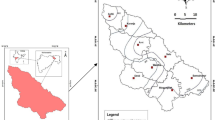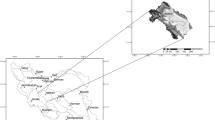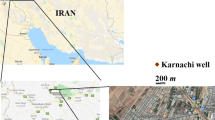Abstract
Spatiotemporal groundwater quality simulation is very important for management of water resources and environmental activities. The present study integrated a number of hybrid methods such as Adaptive Neuro Fuzzy Inference System (ANFIS) with Genetic Algorithm (GA), and ANFIS with Partial Swarm Optimization (PSO) to simulate three groundwater quality parameters in Kerman plain (including Chloride concentration, Electrical Conductivity (EC), and PH). This research investigated the abilities of hybrid techniques as well, to predict groundwater quality. Considering the complexity of different aquifer materials and difficulty of collecting desirable samples, as it is both time- and cost-consuming, a number of hybrid models have been developed, presuming various combinations of monthly variables of rainfall and groundwater level and three different quality parameters. The results suggested that both models indicated an acceptable efficiency in the spatiotemporal simulation of groundwater quality. The study also revealed that groundwater level fluctuations across the aquifer as well as rainfall contribute as two important factors in predicting groundwater quality.











Similar content being viewed by others
References
Adamowski J, Chan HF (2011) A wavelet neural network conjunction model for groundwater level forecasting. J Hydrol 407:28–40
ASCE Task Committee on Application of Artificial Neural Networks in Hydrology (2000) Artificial Neural Networks in Hydrology. I: Preliminary Concepts. J Hydrol Eng ASCE 5(2):115–123
Bashir ZA, El-Hawary ME (2009) Applying wavelets to short-term load forecasting using PSO-based neural networks. IEEE Trans Power Syst 24(1):20–7
Chiu SL (1994) Fuzzy model identification based on cluster estimation. J Intell Fuzzy Syst 2:267–278
Dixon B (2005) Applicability of neuro-fuzzy techniques in predicting ground-water vulnerability: a GIS-based sensitivity analysis. J Hydrol 309:17–38
Eftekhari M, Katebi SD, Karimi M, Jahanmiri AH (2008) Eliciting Transparent Fuzzy Model using Differential Evolution. Appl Soft Comput 8:466–476
Goldberg DE (1989) Genetic Algorithms in Search, Optimization, and Machine Learning. Addison-Wesley, Inc, Reading
Jalalkamali A, Sedghi H, Manshouri M (2011) Monthly groundwater level prediction using ANN and neuro-fuzzy models: a case study on Kerman plain, Iran. J Hydroinf 13(4):867–876
Jang JSR (1993) ANFIS: Adaptive-network-based fuzzy inference systems. IEEE Trans Syst Man Cybern 23(3):665–685
Kennedy J (1998) The behavior of particle. In: Proceedings of the 7th annual conference on evolutionary programming
Kennedy J, Eberhart R (1995) Particle swarm optimization. In: Proceedings of the IEEE international conference on neural networks
Kuo YM, Liu CW, Lin KH (2004) Evaluation of the ability of an artificial neural network model to assess the variation of groundwater quality in an area of black foot disease in Taiwan. Water Res 38:148–158
Mishra A, Ray C, Kolpin D (2004) Use of Qualitative and Quantitative Information in Neural Networks for Assessing Agricultural Chemical Contamination of Domestic Wells. J Hydrol Eng ASCE 9(6):502–511
Nourani V, Mogaddam A, Nadiri AO (2008) An ANN-based model for spatiotemporal groundwater level forecasting. Hydrol Process 22:5054–5066
Sahoo GB, Ray C, Mehnert E, Keefer DA (2006) Application of artificial neural networks to assess pesticide contamination in shallow groundwater. Sci Total Environ 367:234–251
Seyam M, Mogheir Y (2011) A new approach for groundwater quality management. Islam Univ J (Series of Natural Studies and Engineering) 19(1):157–177
Sugeno M (1985) Industrial applications of fuzzy control. Elsevier Science Pub.Co, Amsterdam
Wang YM, Elhag T (2008) An adaptive neuro-fuzzy inference system for bridge risk assessment. Expert Syst Appl 34(4):3099–3106
Yesilnacar MI, Sahinkaya E, Naz M, Ozkaya B (2008) 5 Neural network prediction of nitrate in groundwater of Harran Plain, Turkey. Environ Geol 56:19–25
Yu W, Li X (2004) Fuzzy identification using fuzzy neural networks with stable learning algorithms. IEEE Trans Fuzzy Syst 12(3):411–20
Yuan XH, Wang L, Yuan YB (2008) Application of enhanced PSO approach to optimal scheduling of hydro system. Energy Convers Manag 49(11):2966–72
Zho C, Zhou J, Ju Q, Liu D (2008) Prediction of groundwater quality using organic grey neural network model, Bioinformatics and Biomedical Engineering. The 2nd international conference in Shanghai, pp 3168–3171
Author information
Authors and Affiliations
Corresponding author
Additional information
Communicated by: H. A. Babaie
Rights and permissions
About this article
Cite this article
Jalalkamali, A. Using of hybrid fuzzy models to predict spatiotemporal groundwater quality parameters. Earth Sci Inform 8, 885–894 (2015). https://doi.org/10.1007/s12145-015-0222-6
Received:
Accepted:
Published:
Issue Date:
DOI: https://doi.org/10.1007/s12145-015-0222-6




